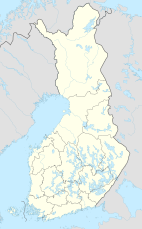Our website is made possible by displaying online advertisements to our visitors.
Please consider supporting us by disabling your ad blocker.
Koli National Park
This article needs additional citations for verification. (October 2020) |
| Koli National Park | |
|---|---|
 An elevated view at Koli | |
| Location | North Karelia, Finland |
| Coordinates | 63°03′27″N 29°53′14″E / 63.05750°N 29.88722°E |
| Area | 30 km2 (12 sq mi) |
| Established | 1991 |
| Visitors | over 236 000 (in 2021[1]) |
| Governing body | Metsähallitus |
| Website | www www |

Koli National Park (Finnish: Kolin kansallispuisto) is a national park in the municipalities of Joensuu, Lieksa and Kontiolahti in the North Karelia region of Finland. It covers 30 square kilometres (12 sq mi) of forested hills on the western shore of Lake Pielinen. The park was established in 1991 and is currently governed by the Metsähallitus.[2] It was originally governed by the Finnish Forest Research Institute, which is also called the Metla.
Koli National Park preserves the traditional agricultural heritage of the area. The park was once a pagan sacrificial site, and was later used for slash-and-burn agriculture.[3] While fields in the park are no longer slashed and burned, hay is cut yearly and traditional Finnish breeds of cow and sheep graze in the meadows of Koli.
According to central protection objectives, Koli National Park is divided into three main zones.
Stringent attention is paid to the natural landscape and geological aspects of the mountaintop zone of Koli. In this culture zone, a variety of traditional landscapes is maintained through burn-beating, grazing, and rotating open fields, among other methods. In particular, the multiform flora of open fields needs annual mowing to be preserved.
In the nature zone is the forest landscape of the hills, which are also protected. Koli's terrain varies widely, allowing for many different biotopes in a small area and a great variety of species. The rocky terrain is relatively rugged but contains dense plant growth.
- ^ "Käyntimäärät kansallispuistoittain 2021" (in Finnish). Metsähallitus. Retrieved April 9, 2021.
- ^ "Metla : Kolin kansallispuisto : Kolin matkailupalvelut monipuolistuvat : Tiedote 3.1.2006" (in Finnish). 2007-09-07. Archived from the original on 2020-04-30. Retrieved February 18, 2008.
- ^ "History of Koli National Park". Nationalparks.fi. Retrieved 2020-10-01.
Previous Page Next Page



